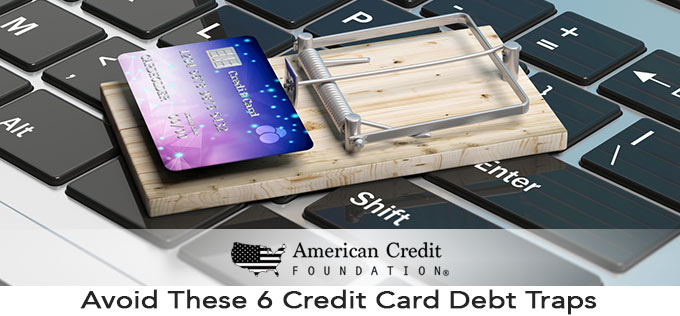
Credit cards are useful tools – if used correctly. Unfortunately, it’s all too easy to find yourself in debt after only using your card for a short time. Why do people so quickly fall into credit card debt? Let’s talk about how to avoid these 6 credit card debt traps:
1. Not Having a Budget
If you don’t know what you’re spending, it’s impossible to budget your money correctly. And what happens if you spend more than you earn? For many people, that means turning to credit cards to make up the difference.
By creating a budget, you’ll understand your spending plan every month. And when you find that shiny new object you don’t have enough money to buy? You won’t put it on your credit card and run up the balance because you have a clear image of your financial situation in your mind.
Here’s How to Handle it:
Sit down and make a list of all your monthly expenses, and then compare that with your monthly income. You can download free budget apps to make the process easier.
2. Carrying a Balance
The best way to use credit cards is to pay them off in full every month. That way, you will never build up debt, and you won’t have to pay the high-interest rates that come with carrying a balance. But not everyone follows this method – and those who don’t, typically end up with credit card debt.
Does this scenario ring a bell? You see something that you want, and even though you know you won’t be able to pay it off at the end of the month, you buy it anyway. That must-have item turns into credit card debt that will end up costing you a great deal more than the store charged you for it.
Here’s How to Handle it:
Do your best to pay off your credit card balance every month. If you can’t quite do it, throw all your extra cash toward the credit card balance until you get it paid off. Then, never charge more than you can pay off at the end of the month again!
3. Not Establishing an Emergency Fund

Life throws us lemons consistently, and that’s why it’s a smart idea to put away some money as an emergency fund. Many financial advisors recommend that you set aside at least $1,000 to $3,000 to cover anything unexpected that comes up.
And because we know things ARE going to come up, having an emergency fund will prevent you from reaching for your credit card to deal with it. That action is a downhill slope: You can’t pay off the amount you charged for the emergency, so the interest begins piling up. Before you know it, you have a mountain of credit card debt.
Here’s How to Handle it:
Today is the day to start an emergency fund! Even if you can only put away $5 a week, do it. Over time, you will grow an emergency fund that you can use instead of your credit card when something unexpected comes up.
4. Carrying Too Many Cards
If you’re the type of person who has all of your colorful credit cards lined up perfectly in your wallet, you may be at risk. When you carry too many cards, it makes it easy to get into credit card debt because you have so many ways to pay for those things you can’t afford.
Imagine that you decide you want to buy a new gadget, but the card you typically use is at its limit. No problem, you think as you pull out another card with no balance on it. Can you see how quickly this could spiral out of control?
Here’s How to Handle it:
Only carry one card with you when you go out. If you have more than one credit card, keep them tucked away safely in your home – and when you go out, leave them there!
5. Paying a Little at a Time
Instead of paying off their credit cards in full every month, some people believe that making minimum payments is fiscally responsible. And while this will keep you in good graces with the credit card company (trust us, they’ll love you!), it won’t do your wallet any good.
When you only make minimum payments, a lot of your payment goes to interest. That means your balance will go down slowly, and if you continue to charge on that card, it will take years to pay it off.
Here’s How to Handle it:
Don’t charge more than you can afford to pay off at the end of the month. Doing so will cause you to pay much more for your purchases.
6. Confusing Wants and Needs
Sure, you want that shiny new object, but do you really need it? Some people get into credit card debt when they can’t distinguish between a want and a need.
And it’s no surprise: Between the advertisements that constantly convince us we need things, to the societal pressure that makes us believe we need to own certain things to fit in, it’s no wonder that some people get caught up in credit card debt. But all those purchases typically satisfy wants instead of needs.
Here’s How to Handle it:
Learn to recognize impulse buying and establish language to prevent you from giving in to it. For example, if you’re thinking about buying something you hadn’t planned on, ask yourself why you need it. If the answer is purely emotional, it’s probably a want and not a need.
Credit card debt is a trap that is easy to fall into. But if you understand the risks and triggers, you can avoid this financially devastating trap. If you are having a difficult time getting out of credit card debt, call the friendly experts at American Credit Foundation. One of our counselors will talk to you about the steps you can take to get your financial life back in order.